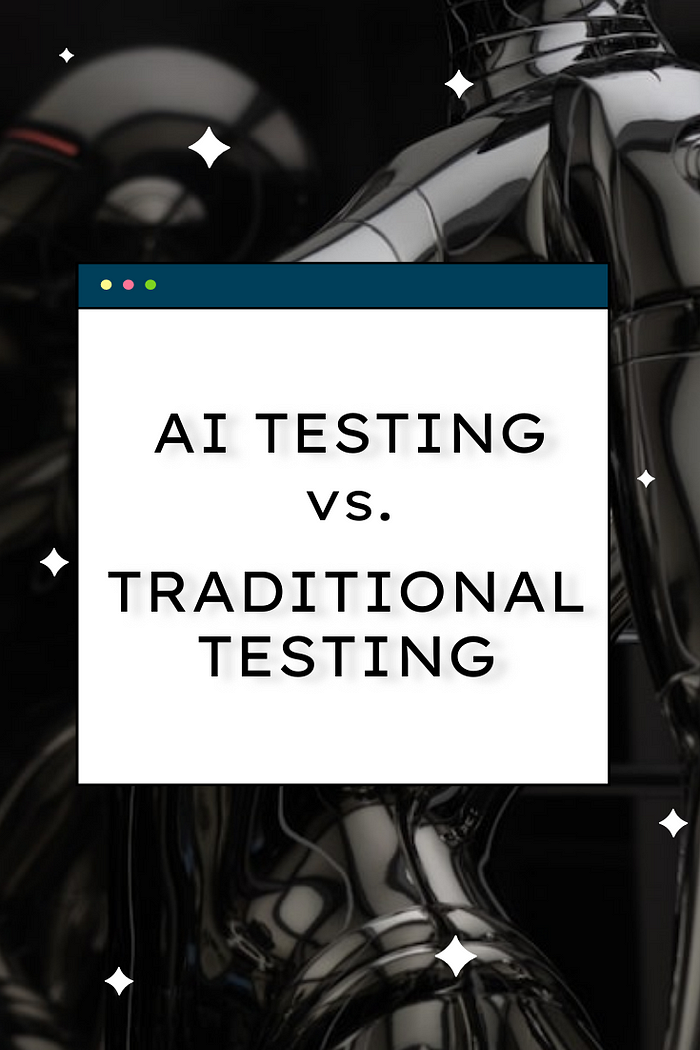AI Testing vs. Traditional Testing
Table of Contents
· Introduction
· Understanding Traditional Testing Methods
∘ Definition and Basics of Traditional Testing
∘ Types of Traditional Testing
· The Emergence of AI Testing
∘ Introduction to AI Testing
∘ Benefits of AI Testing
· Factors to Consider When Choosing Between AI Testing and Traditional Testing
∘ Project Complexity and Scale
∘ Human Expertise and Intuition
∘ Cost and Resource Allocation
· Combining AI and Traditional Testing
∘ The Hybrid Approach
∘ Continuous Improvement and Learning
· Challenges and Limitations
∘ Key Challenges in AI Testing
∘ Limitations of AI Testing Approaches
· Making an Informed Decision
∘ Self-Assessment
∘ Evaluation Criteria
· Conclusion
Introduction
Quality and reliability are the cornerstones of successful software development. As technology continues to evolve, so do the methodologies for ensuring the efficacy of software applications. One of the transformative developments in recent years is integrating artificial intelligence (AI) into software testing processes. In this blog post, we’ll delve into the fascinating realm of AI testing and contrast it with traditional testing methods. By the end, you’ll clearly understand which approach aligns best with your project’s requirements.

Understanding Traditional Testing Methods
Definition and Basics of Traditional Testing
Traditional testing, often called manual testing, relies on the expertise of human testers to identify defects and ensure software functionality. This method involves meticulously creating test cases, executing them, and evaluating the results. However, traditional testing can be time-consuming and is quite familiar with those annoying human errors, even though it allows you to delve into the details.
Types of Traditional Testing
- Unit Testing: This foundational testing phase involves isolating individual components to validate their correctness. While manual unit testing provides a deep understanding of each component, it can be labor-intensive and slow.
- Integration Testing: This step focuses on the interactions between different components to ensure they work together seamlessly. However, manually orchestrating these interactions can be complex and error-prone.
- Regression Testing: Vital for preventing the introduction of new defects, regression testing involves retesting the software after changes. The manual nature of this process often makes it resource-intensive.
The Emergence of AI Testing
Introduction to AI Testing
The integration of AI in software testing has redefined the landscape. AI-powered testing tools use Machine learning algorithms to automate various testing processes. This includes test case generation, execution, and result analysis.
Benefits of AI Testing
- Test Case Generation: AI algorithms can automatically generate test cases by analyzing code and identifying potential scenarios. This significantly enhances coverage and efficiency, making testing more comprehensive.
- Automated Test Execution: AI can execute many tests swiftly, significantly reducing testing cycles. Moreover, eliminating human errors and rapid feedback loops enhance the development process.
Factors to Consider When Choosing Between AI Testing and Traditional Testing
Project Complexity and Scale
The complexity and scale of your project play a crucial role in determining the testing approach. Quality assurance AI testing shines when dealing with large-scale applications that demand efficiency. However, for simpler projects, the overhead of AI may not be justified.
Human Expertise and Intuition
Human testers possess an innate ability to identify subtle issues that might elude automated tools. Balancing AI’s speed with human intuition is essential to catch nuanced defects.
Cost and Resource Allocation
Implementing AI testing involves investment in technology and expertise. On the other hand, manual testing might require more human resources. The decision depends on the project’s budget and long-term goals.
Combining AI and Traditional Testing
The Hybrid Approach
Rather than an all-or-nothing choice, a hybrid approach leverages the strengths of both AI and manual testing. For instance, AI can excel in generating extensive test cases, while human testers provide critical judgment and domain expertise.
Continuous Improvement and Learning
Software testing is an evolving field. It is possible to incorporate AI insights into automated testing processes to improve quality and efficiency further.
Challenges and Limitations
As artificial intelligence (AI) continues to revolutionize various industries, ensuring the reliability and robustness of applications through AI testing has become a paramount concern. AI testing has challenges and limitations that require careful consideration. Let’s delve into some key hurdles and explore potential ways to tackle them.
Key Challenges in AI Testing
- Lack of Domain Expertise for Comprehensive Test Coverage: AI testing used solely for comprehensive test coverage is a tough nut to crack due to the sheer variability and diversity of application inputs. Feeding domain knowledge and human expertise about applications under test to AI systems could be challenging. Furthermore, handling corner cases and edge scenarios, which often lead to unexpected failures, learned through prior testing experience, is not trivial when only using AI for testing.
- Resource-Intensive Nature of Testing: AI testing demands significant computational resources and time-consuming training and validation processes.
Limitations of AI Testing Approaches
- Ethical and Social Implications: AI testing isn’t solely a technical endeavor; it also carries ethical and social implications.
- Bias and Fairness Issues in Testing: AI systems often inherit biases in their training data, leading to unfair outcomes. Ensuring unbiased representation in training data and actively mitigating biases during testing are essential steps when leveraging AI systems for testing.
- Privacy Concerns in AI Testing: Test applications sometimes involve sensitive or personal data. Safeguarding this data during testing processes and preventing leaks is critical to maintaining user trust.
Making an Informed Decision
Self-Assessment
As you assess your testing needs, consider project complexity, human expertise, and budget constraints. Align these with the strengths of software testing AI and traditional testing.
Evaluation Criteria
To aid your decision-making process, here’s a quick comparative table:

Conclusion
Choosing between AI and traditional testing is a nuanced decision that depends on your project’s unique characteristics. You will guarantee high-quality software and accelerate your development by understanding each approach's benefits and limitations. Software testing is ever-evolving, and staying informed about emerging trends is essential for continued success.

Comments
Post a Comment